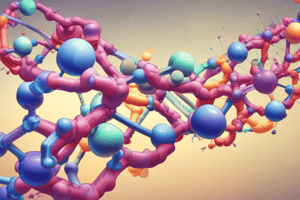Podcast
Questions and Answers
What are high-energy electrons associated with NADH or FADH2 transferred through?
What are high-energy electrons associated with NADH or FADH2 transferred through?
- Specific electron carriers in the electron-transport chain of the inner mitochondrial membrane (correct)
- Iron-sulfur proteins
- Copper atoms
- Cytochromes
What are coenzymes derived from?
What are coenzymes derived from?
- Proteins
- Lipids
- Vitamins (correct)
- Carbohydrates
What is the active form of an enzyme called?
What is the active form of an enzyme called?
- Apoenzyme
- Holoenzyme (correct)
- Coenzyme
- Prosthetic group
What is the inactive form of an enzyme called?
What is the inactive form of an enzyme called?
What happens to an enzyme when it loses its cofactor?
What happens to an enzyme when it loses its cofactor?
Which type of electron carrier is a lipid-soluble molecule?
Which type of electron carrier is a lipid-soluble molecule?
Which type of electron carrier contains heme prosthetic groups bearing Fe or Cu metal ions?
Which type of electron carrier contains heme prosthetic groups bearing Fe or Cu metal ions?
How many distinct cytochrome types are present in the electron-transport chain?
How many distinct cytochrome types are present in the electron-transport chain?
How did scientists determine the sequence of carriers in the electron-transport chain?
How did scientists determine the sequence of carriers in the electron-transport chain?
What is the major flavoprotein of the mitochondria?
What is the major flavoprotein of the mitochondria?
What is the partially reduced molecule of ubiquinone called?
What is the partially reduced molecule of ubiquinone called?
What is the fully reduced molecule of ubiquinone called?
What is the fully reduced molecule of ubiquinone called?
Which molecule has a more positive redox potential compared to NAD+?
Which molecule has a more positive redox potential compared to NAD+?
Which enzyme catalyzes the conversion of citrate to isocitrate in the TCA cycle?
Which enzyme catalyzes the conversion of citrate to isocitrate in the TCA cycle?
Which coenzyme transfers pairs of electrons from substrates to coenzymes?
Which coenzyme transfers pairs of electrons from substrates to coenzymes?
Which molecule is a stronger reducing agent than NADH?
Which molecule is a stronger reducing agent than NADH?
Which enzyme catalyzes the conversion of -ketoglutarate to succinyl-CoA in the TCA cycle?
Which enzyme catalyzes the conversion of -ketoglutarate to succinyl-CoA in the TCA cycle?
Which molecule is indicated by Eo’ rather than Eo at pH 7?
Which molecule is indicated by Eo’ rather than Eo at pH 7?
Which reaction couple has a standard redox potential of -0.32V?
Which reaction couple has a standard redox potential of -0.32V?
Which molecule binds loosely to the active site of an enzyme and aids in substrate recruitment?
Which molecule binds loosely to the active site of an enzyme and aids in substrate recruitment?
Which molecule is a cofactor?
Which molecule is a cofactor?
Which enzyme catalyzes the conversion of succinate to fumarate in the TCA cycle?
Which enzyme catalyzes the conversion of succinate to fumarate in the TCA cycle?
Which molecule is a reducing agent?
Which molecule is a reducing agent?
Which molecule has a standard redox potential of -0.58V?
Which molecule has a standard redox potential of -0.58V?
Study Notes
Electron Transport and Coenzymes
- High-energy electrons associated with NADH or FADH2 are transferred through the electron transport chain (ETC).
- Coenzymes are derived from vitamins, which act as essential organic molecules facilitating enzymatic reactions.
- The active form of an enzyme is known as the holoenzyme, while the inactive form is referred to as the apoenzyme.
Enzyme Cofactors
- When an enzyme loses its cofactor, it generally becomes inactive and can no longer facilitate its specific biochemical reactions.
- Lipid-soluble molecules serve as electron carriers, allowing the transfer of electrons within membranes.
Cytochromes and Flavoproteins
- The electron transport chain contains distinct types of cytochromes, which function in electron transfer reactions.
- Scientists determined the sequence of carriers in the electron transport chain through the use of biochemical experimentation and analysis of electron flow.
Ubiquinone and Redox Potential
- The major flavoprotein found in mitochondria is called flavin mononucleotide (FMN).
- The partially reduced molecule of ubiquinone is known as semiquinone, while the fully reduced form is ubiquinol.
- Ubiquinol has a more positive redox potential compared to NAD+, making it a stronger oxidizing agent in electron transport.
TCA Cycle Enzymes
- The enzyme aconitase catalyzes the conversion of citrate to isocitrate in the TCA cycle.
- The coenzyme involved in transferring pairs of electrons from substrates to coenzymes is often NAD+ or FAD.
- NADH, when oxidized, reveals that it is a stronger reducing agent compared to other common electron carriers.
Specific Enzymatic Conversions in TCA Cycle
- The enzyme alpha-ketoglutarate dehydrogenase catalyzes the conversion of α-ketoglutarate to succinyl-CoA in the TCA cycle.
- Standard redox potential values are critical in biochemistry; one reaction couple has a standard redox potential of -0.32V.
- An enzyme called succinate dehydrogenase catalyzes the conversion of succinate to fumarate in the TCA cycle.
Active Sites and Cofactors
- Molecules that bind loosely to the active site of an enzyme, aiding in substrate recruitment, are often referred to as enzyme substrates or auxiliary factors.
- Cofactors are inorganic ions or organic molecules that assist in the catalytic activity of enzymes.
- A molecule with a standard redox potential of -0.58V contributes to understanding free energy changes and electron transfer efficiency in biochemical reactions.
Studying That Suits You
Use AI to generate personalized quizzes and flashcards to suit your learning preferences.
Related Documents
Description
Test your knowledge of oxidative phosphorylation and redox potentials with this quiz. Explore the role of electron transfer in ATP formation and understand the concept of redox potential.




